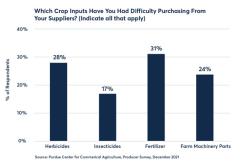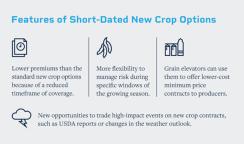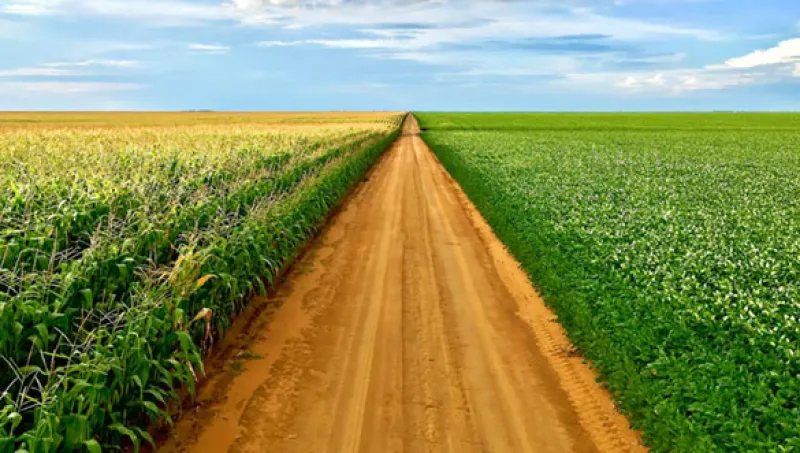By Debbie Carlson for CME Group
AT A GLANCE
- With estimates of input costs at all-time highs, analysts are projecting lower profits in 2022, while producers face big planting decisions
- Some producers have turned to short-dated options to manage rising costs and prepare for major USDA reports
The U.S. Department of Agriculture forecasts net farm income rose 20% in 2020 relative to 2019, and is forecast to be up 23% in 2021. However, with higher costs across the board for inputs, farmers are cautious going into spring planting and are reviewing their risk-management strategies to protect income.
In December, the Ag Economy Barometer from CME Group and Purdue University revealed that 57% of surveyed producers said they expect farm input prices in 2022 to rise by more than 20% compared to 2021. Nearly 40% said they expect input prices to rise by more than 30%.
Economists at the University of Illinois estimate positive farmer returns for 2022, at $61 an acre for corn and $67 an acre for soybeans. However, that is down considerably from 2021’s projected returns of $378 an acre for corn and $305 for soybeans. The university based those figures on a $5/bushel corn price and $12/bushel for soybeans.
Fertilizer Prices More Than Double
Fertilizer costs saw some of the biggest jumps in 2021. A study by the Texas A&M Agricultural and Food Policy Center found that that fertilizer prices could increase by more than 80% for the 2022 planting season.
Betsy Leager of Leager Farms in the Delmarva area of eastern Maryland can attest to the higher fertilizer costs. The sixth-generation grain farmer, who farms 5,000 acres with her husband and four sons, noted her nitrogen costs rose to over $300 a ton from $125 earlier in 2021, making it her top concern for 2022.
The University of Illinois estimates total direct farmer costs for 2022, including fertilizer, pesticides, seed, drying, storage and crop insurance at $512 an acre, up from $391 in 2020.
Leager is in an area where she can mitigate some of the higher synthetic fertilizer costs by using chicken manure on the fields since it contains similar nutrients for crops, but her operation must deal with higher costs for other inputs such as seed and land rents. Energy prices are another top concern for Leager, especially as crude-oil prices rebounded from 2020 lows and propane prices are up.
Machinery costs also saw significant rises. The University of Illinois noted total machinery costs in 2021 for a 310 PTO horsepower tractor rose 15% versus 2017, when calculating overhead, fuel and labor costs to run the tractor. Overall the university estimates total power costs, including fuel and oil, utilities, machine repair and other costs, at $162 in 2022, up from $131 in 2020.

Doug Kirk of Terra Plana Family Farms, which operates 8,500 acres in central Illinois, says his biggest concern around inputs now is whether he can procure them at all. He is trying to get substitutes purchased and delivered because certain brands of pesticides and fertilizers are not available. “So as bad as the price increase is, and it's no fun, now the question is more ‘can we even get it?” he says, noting he’s also having difficulty getting certain machinery parts.
The December Ag Barometer from CME Group and Purdue University revealed 31% of surveyed producers reported difficulties in purchasing fertilizer, while 28% reported problems acquiring herbicides and 24% had trouble purchasing machinery parts.
Managing Costs Through Short-Dated Options
Leager tries to lock in all of her input costs at the beginning of the season, except for diesel fuel, which they buy on the open market. To manage all of these costs, she is starting to use short-dated new crop options because she can get a sense of where her profit margin will be even before planting. “They help with our bottom-line profit,” she says.For the first time Kirk started using standard options to hedge some of his energy prices. He also uses short-dated options for crop futures, especially ahead of the major USDA reports, and he’s going to continue to use them in 2022. Part of it is a way to mitigate higher input costs, but also as a tactical way to take advantage of short-term price swings.
Read more about short-dated new crop options.
“We continue to see spikes around cost the of energy and food. While the prices offered today are pretty good prices, they don't fix the input cost problems,” Kirk says. “We want to be in the game if there is a spike to, let's say, $6 corn, or $14 beans. So we will, at least through March 31 planting intentions report, own short-dated options around that report.”
Short-dated options allow users to manage risk during a specific window, such as crop reports or weather events, and because of a shorter time value, the premiums are lower than standard crop options. That also offer users the flexibility to manage risk more precisely and cost-effectively throughout the growing season at a reduced cost.
John Georgy, chief financial officer for Allendale, Inc. says more of his producer customers are recently showing stronger interest in short-dated options. The market’s volatility and higher margin risk makes options more attractive right now, he says. “You know exactly how much you’re risking when buying option positions, and you’re staying non-marginable in most cases as well,” he says.
Short-dated options allow producers to benefit from a shorter time frame and they do not have to hold the cost for an extended period, Georgy says. Recently, this has not been the case with various shorter-dated options available.
“We find with this volatility, a lot of people can be hesitant about the premium with options, so they are sticking to shorter terms because they can afford it and it’s more manageable,” he says.
Decisions on Spring Planting
Kirk says because certain pesticides aren’t available, he’s changing some of his tillage practices, which means he’s adjusting some operations. Both Leager and Kirk say they are expecting to plant different crops depending on what input costs might be, with both of them considering shifting acreage from corn to soybeans or other crops heading into spring.That’s unusual for both of them because they follow the traditional crop rotation of corn after soybeans to take advantage of the symbiotic relationship the two crops enjoy.
“We pretty much rotate year in, year out to produce the healthiest corn crop because we go to corn for food,” Kirk says.
But economics may make 2022 different.
“We're going to take our lowest-productivity corn acres and shift it to soybeans. That is unusual. The bet is, if it's going to take an extra 20%, or whatever the cost might be to put both those crops in the ground, I'd rather bet on high-producing acres and grow soybeans on those lower producing acres, even if that soybean yield takes a bit of a hit,” he says.
For more information and daily recaps of corn, soybean and wheat markets, sign up to receive CME Group Ag Intel.
Read more articles like this at OpenMarkets






